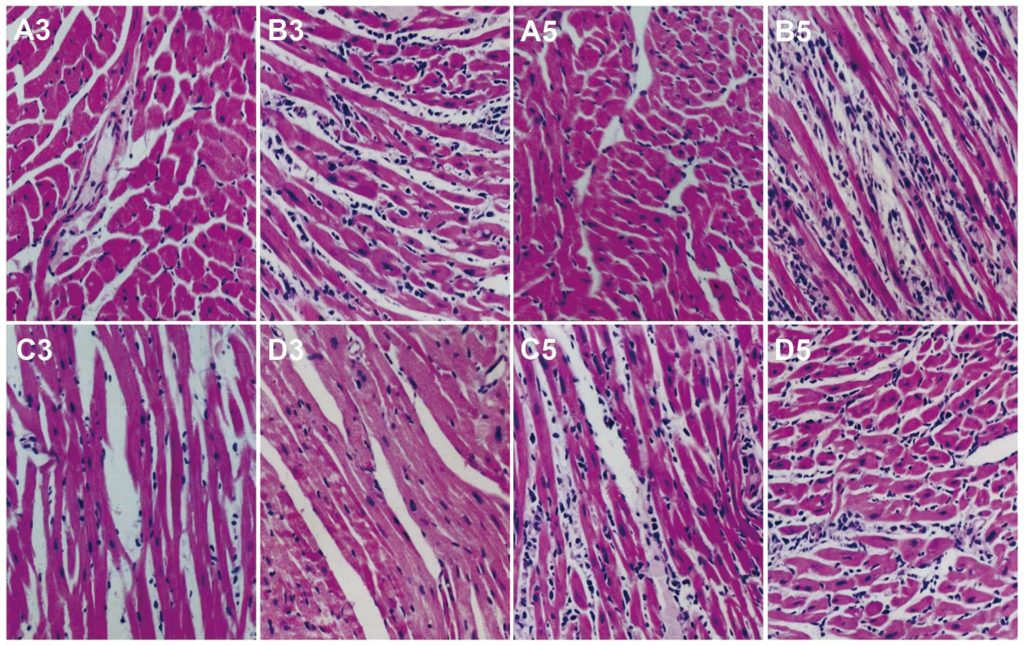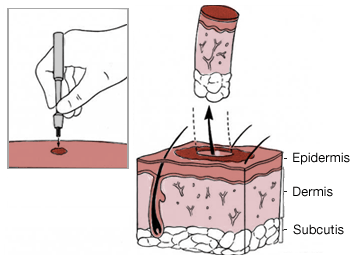[:en]
It is very important to understand that, up until today, it is very unlikely to have 100% guarantee that any diagnosis made in this manner is correct, basing it on the specialist opinion alone. Normally the easiest basic test your doctor or GP applies is the ABCDE rule. This is when the doctor tries to exclude that the particular lesion may be sinister.

Medicine is never an exact science and currently, the only known way to have the best degree of certainty that you have a correct diagnosis of each lesion on your body is the use of histological examinations. A histological examination is a detailed observation of the tissue of a living organism under the microscope. By looking at the microscope one can have the best chances to make the most accurate diagnosis currently possible.

A punch biopsy of the skin. The sample will be sent to the lab for histological examination. A punch biopsy is generally only performed if the doctor deems necessary to perform further investigations.
To this day, the problem with histological examinations is that it is still impractical to perform on all the lesions on our body for two reasons:
→ Generally, because in order to extract the cell of the particular lesion a biopsy is required. Biopsies are rather invasive and are very likely to leave a scar. Also, it would be impractical to perform a biopsy on each lesion on our bodies because there are so many of them.
→ The real resources allocated (i.e costs) to performing a histological examination itself are relatively significant.
For these two reasons (scarring and costs), the doctor or specialist, normally makes an estimation of likely the lesions may be benign (harmless), alternatively how likely they maybe are something quite sinister. In case the perceived likelihood of the lesion to be nonbenign is relatively high, the doctor will opt to perform a punch biopsy to send the sample taken to the lab for a histological examination.
In this way, the diagnosis although not 100% accurate will have the best compromise in terms of invasiveness and costs, while hopefully still maintaining an acceptable degree of accuracy.[:es]
Es muy importante entender que, hasta hoy, es muy poco probable que tenga un 100% de garantía de que cualquier diagnóstico realizado de esta manera sea correcto, basándose únicamente en la opinión del especialista. Normalmente, la prueba básica más sencilla que aplica su médico o médico de cabecera es la regla ABCDE. Esto es cuando el médico intenta excluir que la lesión particular puede ser siniestra.

La medicina nunca es una ciencia exacta y en la actualidad, la única forma conocida de tener el mejor grado de certeza de tener un diagnóstico correcto de cada lesión en su cuerpo es mediante el uso de exámenes histológicos. Un examen histológico es una observación detallada del tejido de un organismo vivo bajo el microscopio. Al observar el microscopio, uno puede tener las mejores posibilidades de hacer el diagnóstico más preciso posible en la actualidad.

Una biopsia por punción de la piel. La muestra se enviará al laboratorio para su examen histológico. Por lo general, una biopsia por punción solo se realiza si el médico lo considera necesario para realizar investigaciones adicionales.
Hasta el día de hoy, el problema con los exámenes histológicos es que todavía no es práctico realizar todas las lesiones en nuestro cuerpo por dos razones:
→ Generalmente, porque para extraer la célula de la lesión particular se requiere una biopsia. Las biopsias son bastante invasivas y es muy probable que dejen una cicatriz. Además, no sería práctico realizar una biopsia en cada lesión de nuestro cuerpo porque hay muchas de ellas.
→ Los recursos reales asignados (es decir, los costos) para realizar un examen histológico en sí son relativamente significativos.
Por estas dos razones (cicatrización y costos), el médico o especialista, normalmente hace una estimación de las posibles lesiones que pueden ser benignas (inofensivas), o la probabilidad de que sean algo bastante peligroso. En caso de que la probabilidad percibida de que la lesión no es benigna sea relativamente alta, el médico optará por realizar una biopsia por punción para enviar la muestra tomada al laboratorio para un examen histológico.
De esta manera, el diagnóstico, aunque no es 100% exacto, tendrá el mejor compromiso en términos de invasividad y costos, mientras se espera que aún se mantenga un grado aceptable de precisión.[:]
